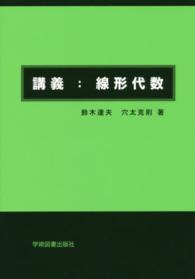- ホーム
- > 洋書
- > 英文書
- > Science / Mathematics
Full Description
Fortran remains one of the principal programming languages used in high-performance scientific, numerical, and engineering computing. A series of significant revisions to the standard versions of the language have progressively enhanced its capabilities, and the current standard - Fortran 2023 - brings with it further additions and improvements. The language as defined by its most recent standards, with their introduction of object-oriented programming and of coarrays, is often referred to generically as 'Modern Fortran', and this term is increasingly used in the literature.
Thus, we see that Fortran's particular advantages as a high-end numerical language, especially where arrays are the main form of data object and/or where complex arithmetic is involved, are still to the fore. It is able to attain the highest achievable optimization, mainly because multi-dimensional arrays are 'natural' objects and because its pointers are highly constrained. There is every sign that Modern Fortran will continue to be used to tackle major scientific computing problems in the next decade and beyond and will long remain a living tribute to its early pioneers.
This third edition of Modern Fortran Explained expands on the second. The material contained in the four final chapters of the second edition have been merged into the main text, thereby offering, in 20 chapters, a comprehensive and uniform description of Fortran 2018. The additional features now brought by the 2023 standard, which are mostly relatively minor in nature, are described in two final chapters, the first on generic programming and the second on the other features. This structure enables the reader to distinguish clearly between what is old and what is new.
This new edition, written by experts in the field, three of whom have actively contributed to Fortran 2023, is thus a complete and authoritative description of Fortran in its latest form, with the intention that it remain the main reference work in the field.
Contents
1: Whence Fortran?
2: Language elements
3: Expressions and assignments
4: Control constructs
5: Program units and procedures
6: Allocation of data
7: Array features
8: Specification statements
9: Intrinsic procedures and modules
10: Data transfer
11: Edit descriptors
12: Operations on external files
13: Further type parameter featur
14: Abstract interfaces and procedure pointers
15: Object-oriented programming
16: Submodules
17: Coarrays
18: Coarray teams
19: Floating-point exception handling
20: Basic interoperability with C
21: Interoperating with C using descriptors
22: Generic programming
23: Other Fortran 2023 enhancements
A: Deprecated features
B: Obsolescent and deleted features
C: Significant examples
D: Solutions to exercises








